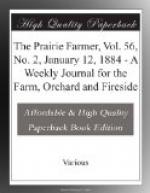The fattening yards are situated between the two ponds, and so arranged as to inclose a portion of the stream.
The ducklings are marketed as fast as they reach a suitable age and size. She commences sending them to market about the middle of June and keeps it up till about the middle of September, when she quits till near the middle of January. These prime young ducks, getting into market at a time when such poultry is scarce, bring good prices—from 22 to 25 cents a pound, dressed. By the time the price begins to decline she has marketed all the earlier ones that she cares to spare, and the later-hatched she keeps growing till mid-winter, when fine ducks are again scarce and the price goes up. At Thanksgiving and during the holidays when the markets are crowded with poultry of all kinds, she holds on to her ducks, unless she has an order at an extra price.
At first my friend kept the Rouens; then she tried the Aylesburys, but now she keeps only the pure Pekins, and is so well satisfied with them that she has no desire to change for anything else. She says, “For laying qualities, quick growth, great size, fine flesh and fine feathers, the Pekins can not be excelled.”
On her place I have seen six-weeks old Pekins that weighed six pounds a pair alive, and those that dressed from three to four pounds each at ten or twelve weeks. At five and six months her ducks dress from six to eight pounds each. For the feathers, the best and finest of which are carefully saved by themselves, my friend obtains forty cents per pound.
All the work connected with the duck-raising, except now and then some heavy work which is necessary in the pond lot, is now performed by my friend and her three children, a boy of fifteen, and two girls of thirteen and eighteen.
There is a moral to this, but if you can’t find it it will not do you one bit of good.
FANNY FIELD.
* * * * *
CONSUMPTION CURED.
An old physician, retired from practice, having had placed in his hands by an East India missionary the formula of a simple vegetable remedy for the speedy and permanent cure of Consumption, Bronchitis, Catarrh, Asthma and all throat and Lung Affections, also a positive and radical cure for Nervous Debility and all Nervous Complaints, after having tested its wonderful curative powers in thousands of cases, has felt it his duty to make it known to his suffering fellows. Actuated by this motive and a desire to relieve human suffering, I will send free of charge, to all who desire it, this recipe, in German, French, or English, with full directions for preparing and using. Sent by mail by addressing with stamp, naming this paper.
W.A. NOYES, 149 Power’s Block, Rochester, N.Y.
* * * * *
A GUILT frame—the prison window.




